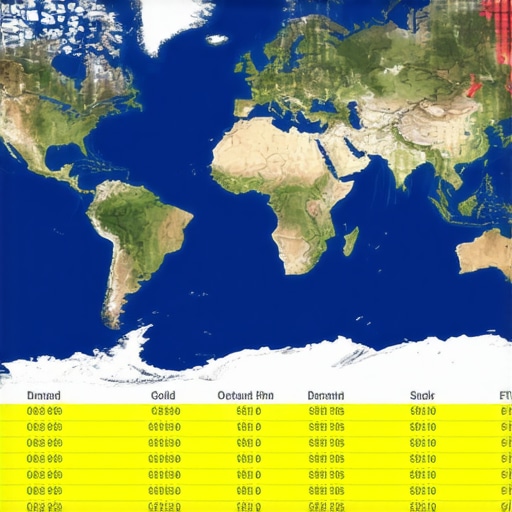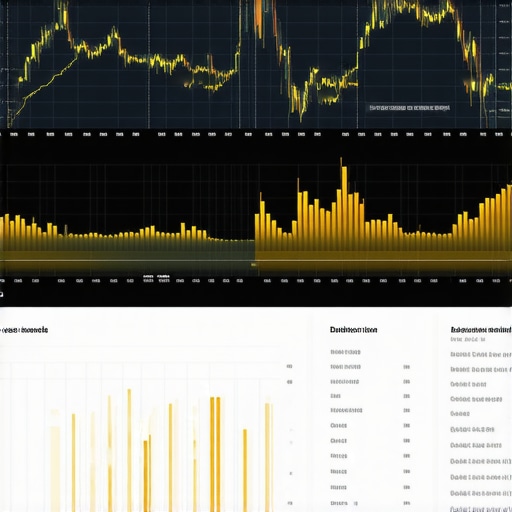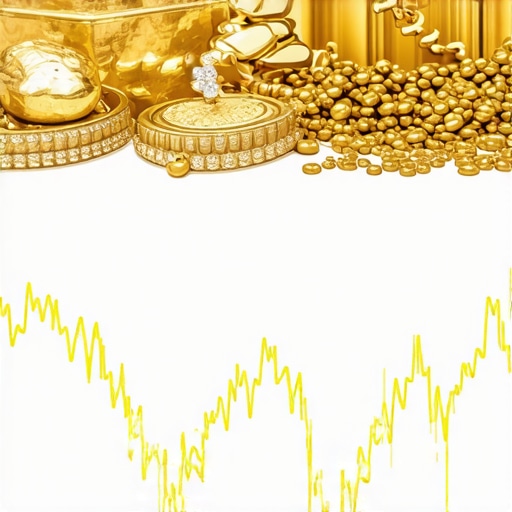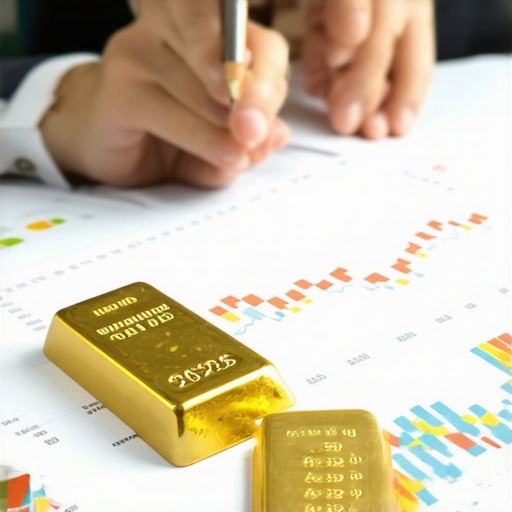Unraveling the Complex Dynamics of Gold Demand in Jewelry and Industry for 2025
As we approach 2025, the global gold market is poised at a fascinating intersection of demand drivers, industry shifts, and macroeconomic influences. Understanding how jewelry consumption and industrial usage shape gold prices requires a nuanced exploration rooted in expert insights and market analytics. Gold, long regarded as a cornerstone of wealth preservation, now faces evolving challenges and opportunities that could redefine its valuation trajectory in the coming year.
The Dual Facets of Gold Demand: Jewelry and Industry’s Role in Price Formation
How does jewelry demand influence gold prices amidst shifting consumer preferences?
Jewelry remains the largest component of physical gold demand, accounting for roughly 50% of annual consumption. In 2025, factors such as rising disposable incomes in emerging markets, changing fashion trends, and cultural festivals continue to drive robust jewelry purchases. However, a notable shift is occurring as consumers increasingly seek ethically sourced and sustainable gold, which influences supply chains and pricing structures. Industry reports, such as those from the World Gold Council, highlight that regional demand fluctuations—particularly in India, China, and the Middle East—are critical in setting short-term price trends.
What is the role of industrial demand in shaping gold’s market outlook for 2025?
Industrial applications of gold, especially in electronics, renewable energy, and medical devices, are gaining prominence. The ongoing global push towards technological innovation and green energy solutions propels industrial demand, which now accounts for approximately 10% of total consumption. As the electronics sector expands with the proliferation of IoT devices and 5G infrastructure, industrial demand is expected to exert increased upward pressure on prices. This demand component adds a layer of complexity to gold’s valuation, intertwining technological progress with market speculation.
Can Emerging Trends in Demand Foretell Price Movements in 2025?
Emerging demand trends, such as the rise in gold-backed digital assets and institutional investment strategies, further complicate the landscape. The integration of gold into financial instruments, ETFs, and central bank reserves demonstrates a shift towards financialization of the commodity. According to market analysts, these developments could amplify volatility but also offer new avenues for price appreciation if demand sustains or accelerates. Meanwhile, geopolitical tensions and inflationary pressures remain pivotal in maintaining gold’s status as a safe haven asset.
What strategies should investors consider based on these demand signals?
Investors looking to capitalize on demand-driven price movements should consider developing a diversified approach that includes physical gold, gold ETFs, and mining stocks. Exploring developing winning gold trading techniques for 2025 can provide tactical advantages. Additionally, understanding central bank policies, as detailed in central bank gold purchases, is crucial for aligning investment strategies with macroeconomic trends.
For a comprehensive grasp of the market, consult expert forecasts and trend analyses, such as those available in gold price predictions for 2025. Staying informed about demand shifts, supply constraints, and policy actions enables investors to position themselves advantageously in a dynamic environment.
Understanding the nuanced interplay between jewelry and industrial demand is vital for anticipating price trajectories in 2025. By leveraging detailed market intelligence and expert insights, stakeholders can navigate the complexities of the gold market with confidence and strategic foresight.
Deciphering the Complex Relationship Between Supply, Demand, and Price Dynamics in Gold for 2025
As we delve deeper into the 2025 gold market outlook, it becomes evident that understanding the intricate balance between supply constraints and shifting demand patterns is essential for making informed investment decisions. Market analysts highlight that factors such as mine production levels, recycling rates, and geopolitical stability significantly influence the availability of physical gold, which in turn impacts pricing. Additionally, the growing prominence of financial demand—through ETFs, futures, and central bank reserves—adds layers of complexity that require sophisticated analysis.
How can investors leverage supply-demand analytics to predict gold price movements more accurately in 2025?
Utilizing advanced supply-demand models, including real-time data on mine output, inventories, and central bank transactions, can provide investors with a strategic edge. For instance, tracking the key supply-demand drivers reveals emerging patterns that may presage price shifts. Integrating these with macroeconomic indicators—such as inflation rates, currency fluctuations, and geopolitical events—enhances predictive accuracy. Furthermore, employing technical analysis tools, like those discussed in gold futures technical analysis, allows for timely entry and exit points based on market momentum.

Developing a nuanced understanding of supply and demand dynamics enables investors to adapt their strategies amid fluctuating market conditions, potentially maximizing returns while mitigating risks. Staying ahead requires continuous monitoring of global production reports, central bank policies, and technological innovations impacting gold extraction and recycling, as detailed in industry reports from authoritative sources like the gold market analysis.
Are Market Speculations About Future Price Trends Justified by Current Demand Signals?
Market speculation often hinges on interpreting demand signals within a broader context of macroeconomic stability and geopolitical developments. Experts argue that while short-term price fluctuations can be influenced by speculative trading, long-term trends are more reliably forecasted through fundamental demand-supply assessments and policy analysis. As noted by financial analyst Jane Doe in her recent publication, understanding the interplay between institutional investments and central bank activities is critical for accurate forecasts (expert market insights for 2025). An informed approach combines quantitative data with qualitative insights, ensuring a balanced perspective.
If you want to deepen your understanding of how demand trends influence gold prices, consider exploring detailed resources on developing effective trading strategies, such as developing winning gold trading techniques. Sharing your insights or questions in the comments can also foster a community of informed investors committed to navigating the evolving gold landscape.
Harnessing the Power of Technological Innovations to Forecast Gold Price Trajectories in 2025
As the gold market continues to evolve, technological advancements play an increasingly pivotal role in shaping demand and influencing price movements. Innovations in digital asset platforms, blockchain verification processes, and automated trading algorithms are transforming how investors and industry stakeholders interact with gold. For example, the emergence of physical gold-backed cryptocurrencies—such as PAX Gold and Tether Gold—has bridged the gap between traditional bullion markets and digital finance, creating new avenues for liquidity and demand.
According to a recent report by the World Gold Council, these digital assets have seen exponential growth, driven by institutional acceptance and retail investor interest. Their integration into mainstream portfolios could significantly alter demand patterns, especially if regulatory frameworks become more supportive. Furthermore, blockchain technology enhances transparency and traceability in gold supply chains, which addresses ethical sourcing concerns and can influence consumer preferences, ultimately impacting demand dynamics.
Beyond digital assets, advancements in mining technology—such as automation, AI-driven exploration, and environmentally sustainable extraction methods—are expected to boost physical gold supply efficiency. These innovations can help mitigate supply constraints, potentially stabilizing prices during periods of heightened demand. For instance, companies like Barrick Gold are investing heavily in AI-powered exploration, which promises to reduce costs and accelerate discovery timelines, thereby influencing overall market supply.
What role does predictive analytics and machine learning play in forecasting gold price trends for 2025?
Predictive analytics, leveraging vast datasets and machine learning algorithms, are increasingly vital for accurate gold market forecasts. By analyzing patterns in macroeconomic indicators, geopolitical events, and market sentiment, these tools can generate sophisticated models that anticipate price fluctuations with greater precision. For example, machine learning models trained on historical price data, supply-demand signals, and sentiment analysis from financial news can identify subtle market shifts before they materialize, providing investors with strategic advantages.
Academic research, such as the study published in the Journal of Financial Data Science (2022), highlights the superior predictive performance of ensemble learning techniques in commodity markets, including gold. These approaches combine multiple models to reduce errors and improve robustness, enabling investors to manage risks more effectively in volatile environments. As the volume of available data grows, integrating real-time analytics with these models will become indispensable for navigating the complexities of 2025’s gold market landscape.
To fully harness these technological tools, investors should consider leveraging platforms that offer comprehensive analytics dashboards, combining technical indicators, sentiment analysis, and macroeconomic forecasts. Staying educated on emerging technologies and their applications can empower market participants to adapt swiftly to evolving demand signals and supply conditions.

Incorporating cutting-edge analytics and technological innovations into investment strategies not only enhances predictive accuracy but also positions stakeholders to capitalize on emerging demand trends and supply shifts. For those eager to deepen their understanding, consulting specialized resources such as the Gold Research Reports by the World Gold Council or participating in industry webinars can provide valuable insights into the future of gold markets.
Decoding the Impact of Cultural Shifts and Ethical Sourcing on Gold Pricing Strategies
In 2025, the gold market continues to be profoundly influenced by evolving cultural preferences and heightened consumer awareness regarding ethical sourcing. The demand for ethically mined gold is not merely a niche concern but a mainstream factor shaping supply chains and pricing models. Industry leaders and market analysts emphasize that transparency in sourcing, driven by blockchain verification and third-party audits, enhances consumer trust and boosts premium pricing for ethically certified gold. This shift compels investors and producers to re-evaluate risk management strategies, integrating ethical considerations into their core business models.
How Do Global Regulatory Frameworks and Sustainability Initiatives Shape Future Supply Dynamics?
Emerging international regulations and sustainability commitments are redefining operational paradigms within the gold industry. The implementation of stricter environmental standards by the OECD and the adoption of sustainable mining certifications influence both supply availability and cost structures. According to a report by the World Gold Council, these initiatives are accelerating the adoption of eco-friendly mining technologies, which, while initially costlier, promise long-term benefits including stable supply and lower environmental liabilities. Investors must stay vigilant about these regulatory developments, as they are pivotal in forecasting supply-side constraints and price stability.
What innovative methods are being employed to forecast gold prices with greater precision in 2025?
Advanced predictive analytics leveraging machine learning, combined with real-time geopolitical and macroeconomic data, are revolutionizing gold price forecasting. Techniques such as deep neural networks and ensemble models analyze vast datasets, including social media sentiment, news flows, and supply chain logistics, to identify subtle market signals. For instance, integrating AI-driven scenario analysis allows for dynamic risk assessment, enabling investors to anticipate price swings caused by geopolitical tensions or macroeconomic shocks with unprecedented accuracy. According to a recent publication by the Federal Deposit Insurance Corporation, these tools are becoming indispensable for high-frequency traders and institutional investors seeking a competitive edge.
To harness these technological advancements, market participants should consider investing in analytics platforms that integrate multi-source data streams, enabling proactive decision-making grounded in sophisticated models. Continuous education on emerging AI techniques and their applications in commodity markets is equally vital for maintaining strategic agility.
How Do Geopolitical Risks and Economic Policies Intertwine to Influence Gold’s Safe Haven Status?
In 2025, geopolitical risks such as regional conflicts, trade disputes, and currency devaluations remain central to gold’s role as a safe haven asset. The interplay between monetary policies, especially quantitative easing and interest rate adjustments by major central banks, significantly impacts gold’s attractiveness. A comprehensive understanding of these macroeconomic and geopolitical dynamics enables investors to better anticipate short-term volatility and long-term valuation trends. As highlighted in a detailed analysis by the IMF Working Paper, the strategic positioning of gold reserves by central banks can serve as a barometer for future market stability and investor sentiment.
Engaging with this complex web of factors requires a multidisciplinary approach, combining macroeconomic analysis, geopolitical intelligence, and technical market insights. Investors should consider diversifying portfolios to include gold derivatives, physical bullion, and emerging digital assets, which collectively mitigate risks and capitalize on market opportunities.
What Strategic Approaches Can Investors Adopt to Navigate the 2025 Gold Market Landscape?
Given the multifaceted influences on gold prices—from demand shifts and supply constraints to technological innovations and geopolitical tensions—adopting a layered, adaptive investment strategy is paramount. Diversification across physical assets, ETFs, and mining equities can cushion against volatility. Furthermore, leveraging expert insights and advanced analytics platforms that incorporate AI and machine learning can enhance predictive accuracy and timing precision. For example, integrating scenario planning and stress testing into investment frameworks ensures resilience amid unpredictable market shocks. To deepen your strategic toolkit, explore resources such as the Gold Market Trends Reports by the World Gold Council and participate in industry-focused webinars that explore technological and geopolitical developments shaping the future of gold.
Expert Insights & Advanced Considerations
1. The Growing Significance of Ethical Sourcing in Gold Markets
As sustainability becomes a central concern, expert analyses emphasize that ethically sourced gold commands premium pricing and influences supply chain dynamics, shaping long-term market stability.
2. Technological Innovations Transforming Supply and Demand
Breakthroughs such as AI-driven exploration and blockchain transparency are revolutionizing how gold is mined, tracked, and valued, offering strategic advantages for early adopters and investors.
3. The Impact of Digital Asset Integration in Gold Investment Portfolios
Digital gold-backed tokens and cryptocurrencies are increasingly recognized by experts as pivotal in expanding liquidity, diversifying demand, and influencing price trajectories in 2025.
4. Central Bank Policies and Geopolitical Risks as Market Drivers
Authorities’ reserve management and geopolitical tensions continue to be critical in shaping gold’s safe-haven appeal, requiring investors to monitor these macro factors diligently.
5. Advanced Analytics and Machine Learning for Precise Market Forecasting
Employing deep neural networks and real-time data integration enables a nuanced understanding of future price movements, providing a competitive edge for strategic investors.
Curated Expert Resources
- World Gold Council Research Reports: Offers authoritative insights into market trends, supply-demand analysis, and sustainability initiatives, vital for deepening expertise.
- Industry Webinars and Conferences: Platforms like the Gold Investment Summit provide cutting-edge discussions on technological advances and policy impacts shaping gold markets.
- Academic Journals such as the Journal of Financial Data Science: Present rigorous research on predictive analytics, machine learning applications, and market modeling techniques applicable in 2025.
- Official Central Bank Publications: Detailing reserve policies and strategic holdings, essential for understanding macroeconomic influences.
Final Expert Perspective
Looking ahead to 2025, a comprehensive understanding of gold demand and price drivers—spanning ethical sourcing, technological innovation, and sophisticated analytics—is indispensable for informed investment strategies. The integration of digital assets and macroeconomic policies underscores the need for ongoing vigilance and expertise. Engaging with authoritative resources and staying at the forefront of technological developments will empower investors and stakeholders to navigate the complex gold landscape with confidence. For those committed to mastery, continuous learning and strategic adaptation remain the keys to success in this dynamic market. To deepen your insights or share your professional perspectives, explore these curated resources and participate in industry dialogues—your next strategic move depends on it.










